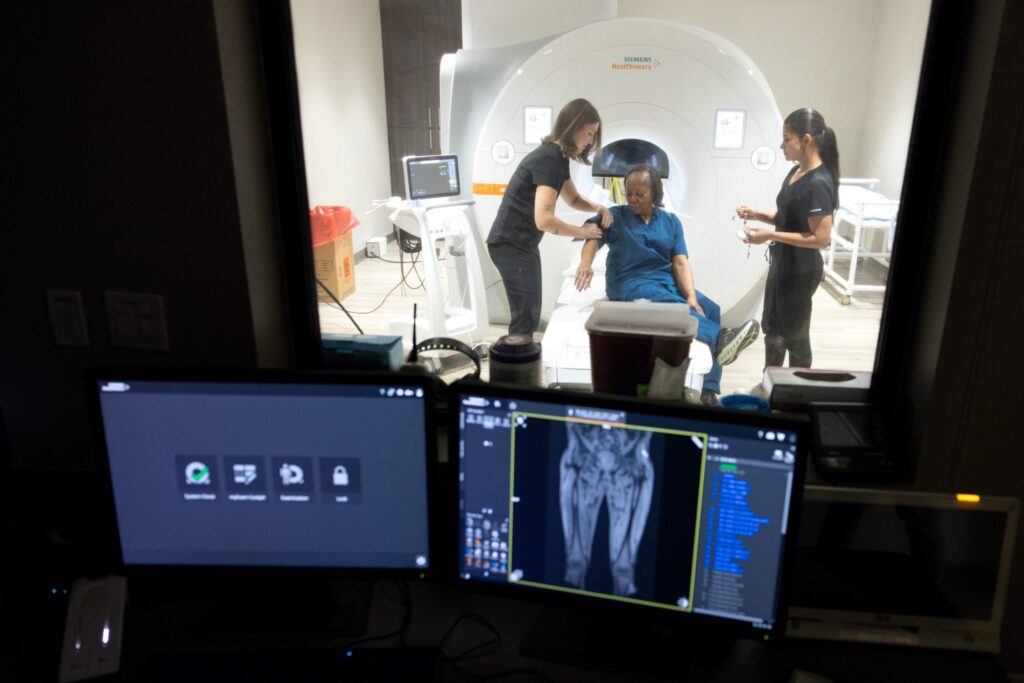Tarrant County has a host of influences that could be affecting the way its residents age.
“For example, Arlington is the largest city in the United States that doesn’t have public transit,” said Michael Nelson, director of the University of Texas at Arlington’s Center for Healthy Living and Longevity. “There are urban and rural areas within Tarrant County, so we can compare and contrast differences.”
To help scientists further understand the impact of these factors, as well as the mechanisms that cause functional decline with age, Tarrant County residents are invited to participate in the Arlington Study of Healthy Aging.
The study is a four-year effort at UTA that will use advanced imaging, genetics, exercise science, neuroscience and remote monitoring to examine age-related declines in heart, brain and muscle health.
It also aims to reduce the impact of disease on older adults and advance the understanding of preventing, slowing and stopping aging-associated issues.
The study is pulling together scientists from various expertises to examine a group of 600 older individuals and identify factors that promote healthy aging. The group will also determine how aging is influenced by social, physical, economic, psychological and behavioral factors, as well as ethnicity, race and sex.
“The advantage is the ability to look at pathophysiologic mechanisms with our comprehensive approach,” Nelson, the study’s lead investigator, said. “We look across the entire body, from head to toe.”
The results of the study will be a primary data source on aging to train the next generation of scientists, Nelson said. It will also provide scientists the opportunity to explore more hypothesis-driven research.
The mission of the league is to develop the potential of women through volunteer action, collaboration and training, 2024-25 President Sarah Washington said.
If you want to join
To be eligible, participants must be between 50 to 80 years old and Tarrant County residents.
If selected, participants will fill out a series of online surveys, be required to attend two in-person visits at UTA and provide a blood sample.
As part of the study, participants will receive:
Physical function exam
Heart and vascular health exam
Free brain, heart and muscle imaging
Memory testing
Monitors to analyze physical activity, sleep and blood pressure
The study is free to join and participants will be compensated for their time. Click here to apply.
Two key spaces are used for the study. One is UTA’s new state-of-the-art Clinical Imaging Research Center, where MRIs are taken. The images will provide unlimited and detailed information about every organ system in the human body, Nelson said.
Researchers are also using the clinical translational research labs in UTA’s Science & Engineering Innovation & Research Building for comprehensive blood pressure screening, vascular function assessments, and physical function measurements, like how fast someone can walk or their strength when getting up from a chair. These factors can directly correlate with brain function, Nelson said.
“We’ll also introduce more unique and novel approaches like multiomics analysis — a hot topic right now — to start looking at broader aspects of what drives the aging process,” Nelson said.
Matthew Brothers, a kinesiology professor at UTA, heads the vascular side of the study, which analyzes blood vessel health. Blood vessels get less healthy with the normal aging process, he said, but can also be affected by modifiable behaviors like a sedentary lifestyle, poor eating behaviors or tobacco use.
The study analyzes blood vessels throughout the body for biomarkers that give insight to their health, known as peripheral vascular function, using a well validated clinical and research tool called flow-mediated dilation, Brothers said.
Brain blood flow responses, measured through an MRI, will also be studied to see how well vessels respond to various perturbations, such as fluctuations in blood pressure.
“When your blood vessels are less healthy, it can contribute to basically every disease that we know of,” Brothers said. “Same idea with cerebral circulation. We know that it is a precursor to cognitive decline, all the way up to Alzheimer’s disease and dementia.”
Participants’ results could help develop strategies to improve blood vessel health and possibly prevent hypertension, diabetes and cognitive decline, Brothers said.
Tracy Greer, psychology professor at UTA, oversees the study’s various cognitive assessments, such as the Montreal Cognitive Assessment, a brief screening tool used to assess language, memory and attention.
Another screening, called the NIH Toolbox Cognition Battery, is a computerized test performed on an iPad. Like the cognitive assessment, it analyzes language, memory and attention, but also executive function, working memory, planning and monitoring information.
“They will serve as a test of how one remembers to do things in the future, like attending an appointment or taking medication,” Greer said.
One of the advantages of the study is the integration of different areas of expertise, Greer said. Integrating results from cognitive tests with other markers like brain health, brain activation, gait and mobility will help detect age-decline associations, she added.
Results from the study will be a jumping off point for future research, Nelson said.
“We can probe more deeply,” Nelson said. “Decades worth of information that will come from it.”
Kathryn Miller is a reporting fellow at the Fort Worth Report. You can contact her at [email protected]. At the Fort Worth Report, news decisions are made independently of our board members and financial supporters. Read more about our editorial independence policy here.
Related
Fort Worth Report is certified by the Journalism Trust Initiative for adhering to standards for ethical journalism.
Republish This Story
![]()


